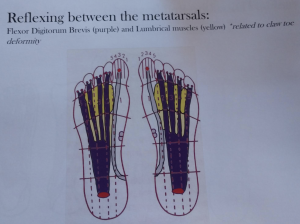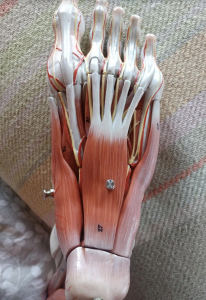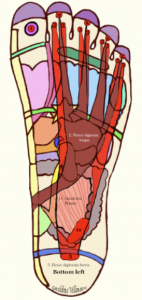 I was recently asked if anything can be done to help “fix” hammer toes. My response is Yes!
I was recently asked if anything can be done to help “fix” hammer toes. My response is Yes!
Hammer-toe is a condition where toe joints are unable to straighten. Often and inadvertently this deformity is caused from:
- A previous injury
- Wearing certain types of shoes which require toes to curl to manage shoes from falling off, or
- Wearing shoes which are too short in length.
These examples minimize function of muscles meant to flex and extend toes as well as inhibit toe joints to glide as they receive weight due to lack of room, or in some cases from forfeited function. As flexor digitorum longus and flexor digitorum brevis muscles become weak they begin to pull at their attachment causing hammer-like, or claw-like toe formation from incessant toe flexion.
What’s the difference between hammer-toe and claw-toe?
Hammer toe happens when the distal toe joint bends downward while the rest of the toe appears straight. Claw toe develops when the intermediate joint of the toe locks in an upwardly raised position to look like a claw.
The flexor digitorum longus muscle originates on the posterior tibia and attaches above the plantar, distal joint of toes five through two. This muscle becomes affected from wearing shoes which are too short for the foot which then creates constant pressure against the end of the toe causing it to bend in a hammer-like position.
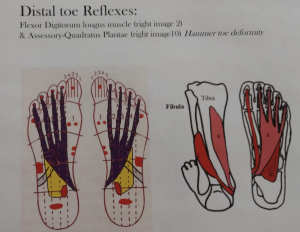
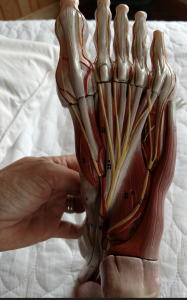
From left to right: Left image is the plantar right and left foot. The darker area leading to distal toes is the flexor digitorum longus muscle. The next image is the posterior leg showing the flexor digitorum longus origin on the tibia, and its plantar attachment crossing the distal toes joint. The photo shows the tendons of the flexor digitorum longus muscle. The quadratus plantae muscle, an assessory to intermediate toe flexion is connected to the 5th flexor digitorum longus tendon and to the heel.
The flexor digitorum brevis muscle originates on the plantar calcaneus and its tendons attach above each intermediate toe joint, five through two. Clenching toes as one does to manage flip-flops, clogs, or shoes without heel traps shortens this muscle causing toes to appear clawed.
From left to right: Image of the plantar right and left foot. The darker area leading from the heel to the intermediate toes is the flexor digitorum brevis muscle. Lumbrical muscles are found in between metatarsal. Second image is a photo showing the flexor digitorum brevis muscle.
Another contributor to the development of hammer and claw toe comes from inert lumbrical muscles. Lumbrical muscles are found in between each metatarsal which function to expand toes and metatarsals and to assist toe joints to glide back and forth to accept and adapt to weight as we walk. Narrow toe-box shoes limit the ability of lumbrical muscles to expand causing toes to become dormant, locked, and arthritic from inactivity. A telling sign of this weakness is demonstrated when one has difficultly spreading their toes. Reflexive symptoms from weak toes manifest as sinus, allergy, and other respiratory issues from inefficient lymph drainage and cleansing that normally comes from the healthy resistance of toe function and their connection to the head.
But there’s a solution to unbind these toe joints!
Here are a few ways to release tension causing hammer and claw toe:
1. Slowly and methodically reflex zones 5-2 following the line of the flexor digitorum brevis and longus muscle from the heel towards the toes. (Press here to learn how to reflex feet)
2. Reflex the area between the waist-line and the pelvic line horizontally to release muscle tension in the quadratus plantae which assists the flexor digitorum brevis muscle with intermediate toe-flexion.
3. Secure thumb and finger just above and below the distal joint of the toe. Keep one hand still while the other hand moves the distal end of this toe upward and downward, and then move the bone side-to-side (this is the nature of the gliding joint). Repeat this method for each joint on the second through fifth toes.
4. Gently stretch each toe upward and hold for 5 seconds, then downward for 5 seconds (Use caution for those who are elderly and or inflamed toe joints).
5. Gently stretch each toe with thumb and finger in a straight line to create space between the joints. You may hear a popping noise, but this is not necessarily the objective.
Before long, with practice and the right shoe hammer-toe and claw-toe will be a condition of the past.
Geraldine Villeneuve is Nationally and Internationally acclaimed as an instructor and practitioner of Structural Reflexology®. She recently received a Research award from the International Council of Reflexologists for her significant contribution to the field of Reflexology. More information about how to take care of your feet can be found on Geraldine’s website: www.PutYourBestFeetForward.com, or you may contact Geraldine at Structuralreflexology@gmail.com.
Archives
- October 2024
- December 2023
- October 2023
- March 2022
- July 2021
- August 2020
- May 2020
- April 2020
- February 2020
- January 2020
- December 2019
- November 2019
- October 2019
- August 2019
- June 2019
- May 2019
- April 2019
- January 2019
- December 2018
- October 2018
- September 2018
- July 2018
- June 2018
- April 2018
- February 2018
- December 2017
- November 2017
- October 2017
- September 2017
- August 2017
- July 2017
- June 2017
- May 2017
- April 2017
- February 2017


